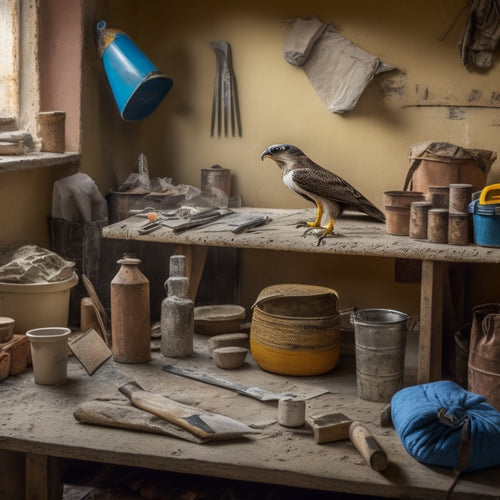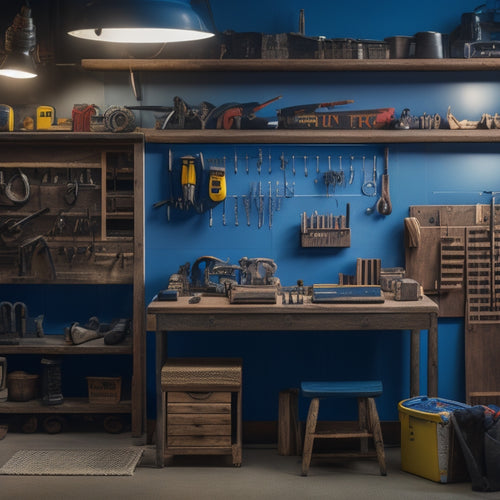
Ultimate Power Tool Checklist for Home Renovation
Share
You'll need a solid arsenal of power tools to tackle your home renovation project, so start with the essentials: drills, drivers, and screwdriver bits for drilling and fastening tasks. For cutting and shaping, invest in a circular saw, jigsaw, and miter saw. Don't forget sanding and polishing tools, like sandpaper, sanding blocks, and polishing compounds. Measure and test with tape measures, laser levels, multimeters, and stud finders. Demolition tools like wrecking bars and jackhammers will also come in handy. Finally, specialized tools like drill presses, rotary hammers, and tile cutters will help you tackle specific tasks with precision and ease. Now, get ready to maximize your renovation's potential.
Key Takeaways
• A comprehensive power tool checklist for home renovation should include drilling and fastening tools, cutting and shaping power tools, and sanding and polishing essentials.
• Essential drilling and fastening tools include cordless and corded drills, drill bits, fastening drivers, screwdriver bits, and nut drivers.
• Cutting and shaping power tools should include a circular saw, jigsaw, miter saw, and cutting efficiency tools for precise cuts and professional results.
• Sanding and polishing essentials include varied sandpaper grits, sanding blocks, polishing compounds, metal polish, and wood polish for achieving desired finishes.
• Measuring and testing devices, demolition and destruction tools, and specialized task power tools should also be included in the ultimate power tool checklist.
Essential Drilling and Fastening Tools
You'll need a reliable drill and a set of bits to tackle various drilling tasks, from hanging shelves to installing cabinets, during your home renovation project.
There are several drill types to evaluate, including cordless, corded, and hammer drills. Cordless drills offer convenience and flexibility, while corded drills provide more power. Hammer drills are ideal for heavy-duty tasks like drilling into concrete or masonry.
When it comes to fastening techniques, you'll need to choose the right drill bits and drivers for the job. Twist bits are versatile and suitable for most drilling tasks, while spade bits are better for drilling large holes.
For fastening, you'll need drivers like Phillips, flathead, and hex keys. Don't forget to invest in a set of screwdriver bits and a nut driver for added convenience.
Cutting and Shaping Power Tools
With your drilling and fastening tasks underway, now it's time to turn your attention to cutting and shaping power tools that'll help you tackle tasks like ripping lumber, cutting curves, and making precise angled cuts. These tools will be your go-to for making precise cuts and shapes in various materials.
Here's a rundown of the essential cutting and shaping power tools you'll need:
| Tool | Benefits | Uses |
|---|---|---|
| Circular Saw | Fast and accurate straight cuts, benefits include ease of use and portability | Ripping lumber, making straight cuts |
| Jigsaw | Versatility for curved cuts, beveling, and plunge cuts | Curved cuts, irregular shapes, and demo work |
| Miter Saw | Precise angled cuts, ideal for trim work and picture framing | Precise angled cuts, trim work, picture framing |
These power tools will help you make accurate cuts and shapes, ensuring your renovation project turns out professional and polished. Whether you're ripping lumber, cutting curves, or making precise angled cuts, having the right cutting and shaping power tools in your arsenal will make all the difference.
Sanding and Polishing Essentials
Your renovation project's success hinges on a smooth, polished finish, and that's where sanding and polishing essentials come into play.
To achieve that perfect finish, you'll need a solid understanding of sanding techniques and the right polishing materials. Start with a variety of sandpaper grits, ranging from coarse to fine, to tackle different surfaces and imperfections.
Don't forget to invest in a reliable sanding block, which will help you maintain even pressure and prevent scratches.
When it comes to polishing materials, you'll need to choose the right compounds and pads for your specific project. For instance, if you're working with metal, you'll need a metal polish and a buffing wheel.
For wood, you'll require a wood polish and a soft cloth. Remember to always follow the manufacturer's instructions and take necessary safety precautions when working with these materials.
Measuring and Testing Devices
Measuring and Testing Devices
Accurate measurements and precise testing are essential to a successful home renovation, and that's where measuring and testing devices come into play. You'll need these tools to guarantee your projects turn out as planned, from measuring room dimensions to testing electrical circuits.
Here are the must-haves in your measuring and testing device arsenal:
| Device | Purpose |
|---|---|
| Tape measures | Measure distances, widths, and heights |
| Laser levels | Guarantee surfaces are level and plumb |
| Multimeter | Test electrical voltage, current, and resistance |
| Stud finder | Locate studs behind walls |
| Level | Check surfaces for levelness and plumbness |
With these devices, you'll be able to take precise measurements, detect potential electrical hazards, and guarantee your renovation projects are structurally sound. Don't start your renovation without them!
Demolition and Destruction Tools
As you prepare for demolition, you'll need the right tools to get the job done efficiently and safely.
You're about to tackle the messy part of your renovation, and it's essential to have the right gear to avoid damaging surrounding structures or injuring yourself.
Now, let's get started with the must-haves: a reliable wrecking bar and a powerful jackhammer.
Wrecking Bar Essentials
You'll rely heavily on a wrecking bar to pry, pull, and demolish materials during your home renovation, making it an essential addition to your toolbox.
Mastering wrecking bar techniques is vital to efficiently and safely completing demolition tasks. To get the most out of your wrecking bar, focus on developing proper grip and stance, as well as learning various prying and pulling techniques.
Remember, safety precautions are paramount when working with a wrecking bar. Always wear protective gear, including gloves, safety glasses, and a dust mask. Guarantee a secure footing and maintain control of the bar at all times.
Here are some essential wrecking bar accessories to take into account:
| Accessory | Description | Importance |
| Pry end | For prying and pulling materials apart | High |
| Chisel end | For breaking and demolishing materials | High |
| Curved end | For maneuvering tight spaces and corners | Medium |
| Extension handle | For increased leverage and reach | Medium |
Jackhammer Operations
Operating a jackhammer effectively requires mastering the proper stance, grip, and body positioning to maximize demolition power while minimizing fatigue and preventing injury.
You'll want to stand with your feet shoulder-width apart, with one foot slightly in front of the other, and hold the jackhammer with both hands, keeping your back straight and your core engaged. This stance will help you maintain balance and generate maximum force.
When it comes to jackhammer safety, always wear protective gear, including safety glasses, ear protection, and gloves. Make certain the area is clear of debris and obstacles, and never operate the jackhammer near flammable materials.
Regular jackhammer maintenance is also essential to guarantee peak performance and extend the tool's lifespan. Check the air compressor regularly, lubricate the hammer's piston, and replace worn-out bits and chisels.
Specialized Task Power Tools
When tackling specific tasks during your home renovation, you'll need specialized power tools that can handle precise and demanding jobs.
You'll appreciate the accuracy of a drill press, the raw power of a rotary hammer, and the ease of a tile cutter when working with delicate materials.
These tools will help you complete tasks efficiently and effectively, ensuring your renovation project turns out exactly as you envisioned.
Drill Press Accuracy
Precision demands a drill press that can deliver accurate holes, guaranteeing your project's success and saving you from costly rework. When it comes to achieving precision, you can't afford to compromise on your drill press's performance. To get the most out of your drill press, you need to focus on two critical aspects: drill press calibration and drill bit selection.
Here are three essential tips to help you achieve accurate holes with your drill press:
-
Calibrate your drill press regularly: Confirm your drill press is properly calibrated to maintain accuracy and prevent errors. Check the manual for calibration instructions specific to your model.
-
Choose the right drill bit: Select drill bits that are suitable for your project's material and the type of hole you need to create. For example, use a twist bit for wood and a step bit for metal.
-
Use a drill press with a built-in laser guide: A laser guide helps you align the drill bit with the mark, guaranteeing accurate hole placement and reducing errors.
Rotary Hammer Power
Tackle tough demolition and drilling tasks with confidence by selecting the right rotary hammer power tool for your project, as it's designed to deliver the brute force and control you need to get the job done efficiently. With the right techniques, you'll be able to drill through concrete, brick, and stone like a pro. But remember, proper maintenance is key to extending the life of your tool and ensuring peak performance.
Here are some key considerations when choosing a rotary hammer:
| Feature | Benefit | Tips |
|---|---|---|
| Power source | Cordless for flexibility, corded for heavy-duty use | Choose a tool with a high amp-hour rating for extended battery life |
| Chuck type | SDS-Plus for versatility, SDS-Max for heavy-duty use | Use the correct bit for the job to prevent damage to the tool or material |
| Speed settings | Variable speed for control, fixed speed for heavy-duty use | Start with a lower speed and increase as needed to maintain control |
| Weight and ergonomics | Lighter weight for reduced fatigue, ergonomic design for comfort | Look for a tool with a comfortable grip and balanced design to reduce strain |
Tile Cutting Ease
After mastering the art of drilling through tough materials with a rotary hammer, you're ready to turn your attention to the finer details of your renovation project, like cutting tiles with ease and precision.
A tile cutter is a specialized power tool that's essential for achieving professional-looking results. With the right tile cutting techniques, you'll be able to make precise cuts, minimize waste, and guarantee a safe working environment.
Here are three key considerations for tile cutting ease and safety:
-
Choose the right blade: Select a blade that's specifically designed for cutting tile, and make sure it's suitable for the type of tile you're working with.
-
Use proper cutting techniques: Keep the tile firmly in place, use a steady and controlled motion, and avoid applying too much pressure.
-
Wear protective gear: Always wear safety goggles, gloves, and a dust mask when cutting tile to protect yourself from flying debris and dust.
Frequently Asked Questions
What Safety Gear Is Necessary for Home Renovation Power Tool Use?
When working with power tools, you're taking a big risk if you don't wear the right safety gear.
You need protective equipment to prevent serious injuries. Start with safety glasses or goggles to shield your eyes from debris.
Add a dust mask to protect your lungs from airborne particles. Don't forget ear protection, gloves, and a hard hat to complete your safety arsenal.
Invest in this gear to guarantee a safe and successful renovation.
Can I Use Power Tools in a Wet or Humid Environment?
When working with power tools, you need to be extra cautious in wet or humid environments. Water and electricity can be a deadly combo, so it's crucial to take wet environment precautions seriously.
Make sure you're using tools with grounded plugs or double insulation, and keep them away from standing water. If you're working outdoors, wait for a dry spell or create a dry zone around your workspace.
How Often Should I Maintain and Clean My Power Tools?
You know regular tool maintenance is key to extending their lifespan and performance.
To keep your power tools in top shape, clean them after every use and perform a deeper clean every 1-2 months.
Check for worn or damaged parts and replace them promptly.
Additionally, follow the manufacturer's recommended maintenance schedule for specific tool maintenance tips.
Do I Need a Dedicated Power Outlet for Each Tool?
Imagine you're the conductor of an orchestra, each tool a unique instrument. Just as each musician needs their own spotlight, each power tool requires a dedicated power outlet to shine.
Don't risk overloading or tripping breakers! Research the power outlet types and tool power requirements to guarantee a harmonious performance.
You'll need a mix of 15- and 20-amp outlets to accommodate tools like circular saws and drill presses. By doing so, you'll create a safe and efficient workspace that's music to your ears.
Can a Beginner Start With a Cordless Power Tool Set?
You're wondering if you can start with a cordless power tool set as a beginner. Absolutely, you can!
Cordless toolkits are perfect for beginners, offering flexibility and ease of use. Plus, they eliminate the hassle of cords and outlets.
The cordless advantages are undeniable - you'll appreciate the convenience and portability.
Beginner toolkits usually include the essentials, like a drill, driver, and multitool, making it easy to immerse yourself in your home renovation projects with confidence.
Conclusion
You've got the ultimate power tool checklist for your home renovation project!
Now, it's time to release your inner DIY warrior and tackle that to-do list.
As you stand victorious amidst the dust and debris, remember: a well-equipped arsenal is only as strong as the master who wields it.
With these power tools by your side, you'll be the master builder of your domain, shaping your space into a masterpiece that's truly the envy of the neighborhood.
Related Posts
-

Top Tools for DIY Home Renovation Plastering Success
To achieve DIY home renovation plastering success, you'll need a range of essential tools. Start with hand tools like...
-

Streamlining Your Exterior Renovation Timeline
To streamline your exterior renovation timeline, start by identifying your project goals and objectives, and prioriti...
-

7 Smart Tool Organization Tips for Small Renovations
As you tackle your small renovation, you're likely wasting precious time searching for misplaced tools. To enhance ef...


